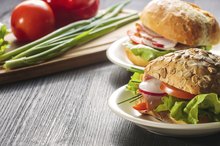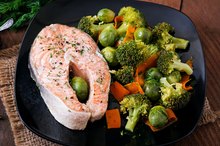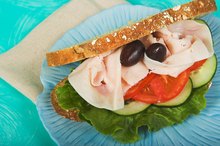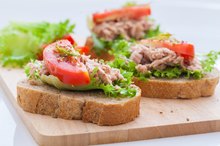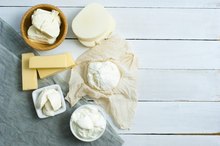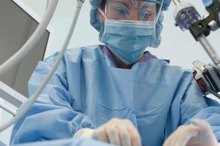Recommended Diet After Gallbladder Removal
The gallbladder is located below the liver. This organ stores the bile, a substance secreted by the liver during fat digestion. The gallbladder may be affected by conditions such as gangrene, abscesses, gallstones and inflammation. This may result in severe pain. Drug therapy is used to treat the condition, but sometimes a cholecystectomy -- removal of the gallbladder -- is necessary 2. Some dietary modifications may be needed to allow the liver to compensate for the gallbladder’s absence.
Limit Fat Intake
After the surgery, a liquid diet may be recommended by your surgeon and then advanced to a regular diet as tolerated. Limiting your fat intake will allow your liver to adapt to the gallbladder’s absence. Limit your fat intake to 30 percent of your total calories. Consume no more than 7 percent of saturated fats and 1 percent of trans fat from your total daily calories. This translates to 67 g of total fat, 16 g of saturated fats and 2 g of trans fat for a 2,000-calorie diet. Avoid fried foods. Refrain from adding fat-based creams, sauces and dressings to your food. Use broiling, braising, boiling, baking and grilling as cooking methods. Read the food label and choose foods with 3 g of fat or less per serving.
- After the surgery, a liquid diet may be recommended by your surgeon and then advanced to a regular diet as tolerated.
- Consume no more than 7 percent of saturated fats and 1 percent of trans fat from your total daily calories.
Lean Protein
A Diet for After Your Gallbladder Has Been Taken Out
Learn More
Select meats with 15 percent of fat or less per serving. Opt for fish, shellfish, chicken and turkey without the skin. Refrain from consuming bologna, potted meat, bacon, hot dogs, sausages, ham, salami and other processed meats; these are high in fat. Also avoid meat and fish canned in oil 3. If you do not eat meat, select lean protein from vegetable sources such as tofu, beans and lentils.
- Select meats with 15 percent of fat or less per serving.
- Also avoid meat and fish canned in oil 3.
Dietary Fiber
The dietary fiber in fruits, vegetables and whole grains will provide satiety in a low-fat diet. Fiber may also help you control the diarrhea symptoms that may be experienced after surgery. Opt for whole grain products such as brown rice, whole grain bread and pasta. Read the label and select foods with 3 g of fiber or more per serving. If gas and bloating are a problem, avoid eating raw vegetables; try cooked and canned vegetables and fruits instead.
- The dietary fiber in fruits, vegetables and whole grains will provide satiety in a low-fat diet.
Beverages
Foods Known to Damage the Liver
Learn More
Stay hydrated. Drink plenty of water and select 100-percent fruit juices with no sugar added. If you can tolerate lactose, select 1-percent or skim milk. Avoid alcoholic drinks; they may add metabolic stress to your liver. Avoid carbonated beverages and beverages that may cause you pain, gas, bloating, discomfort or diarrhea.
- Drink plenty of water and select 100-percent fruit juices with no sugar added.
- If you can tolerate lactose, select 1-percent or skim milk.
Related Articles
References
- American Dietetic Association: Gallbladder Nutrition Therapy
- American Heart Association: Meat, Poultry and Fish
- American Heart Association: Know Your Fats
- Van der Heide F. Acquired causes of intestinal malabsorption. Best Prac Res Clin Gastroenterol. 2016 Apr;30(2):213-24. doi:10.1016/j.bpg.2016.03.001
- Fisher M, Spilias DC, Tong LK. Diarrhoea after laparoscopic cholecystectomy: incidence and main determinants. ANZ J Surg. 2008 Jun;78(6):482-6. doi:10.1111/j.1445-2197.2008.04539.x
- Marcason W. What Medical Nutrition Therapy Guideline Is Recommended Post-Cholecystectomy? J Acad Nutr Dietetics. 2014 Jun;114(7):1136. doi:10.1016/j.jand.2014.05.009
- European Association for the Study of the Liver (EASL). EASL Clinical Practice Guidelines on the Prevention, Diagnosis and Treatment of Gallstones. J Hepatol. 2016 Jul;65(1):146-81. doi:10.1016/j.jhep.2016.03.005
- Office of Disease Prevention and Health Promotion. (2015) 2015-2020 Dietary Guidelines for Americans. Washington, D.C.: U.S. Department of Health and Humans Services.
- Yueh TP, Chen FY, Lin TE. Diarrhea after Laparoscopic Cholecystectomy: Associated Factors and Predictors. Asian J Surg. 2014 Oct;37(4):171-7. doi:10.1016/j.asjsur.2014.01.008
Writer Bio
Based in Arizona, Carmen Gonzalez started writing professionally in 2010. She provides professional insight on nutrition and health topics. She holds a Bachelor of Science in nutrition from the University of Arizona.
